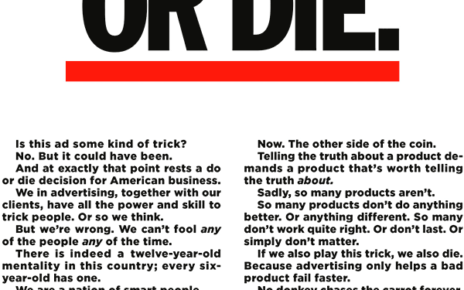ADVERTISING TERMS:
Strategy: general message about the brand to a particular group of consumers. Communication goals, agreed upon by client and agency.
Concepting: brainstorming ways to best communicate strategy message to the intended audience.
Research considerations:
How current customers use the brand.
What’s the current opinion of brand among consumers?
What are competitors doing and saying.
—————————-
MODERN HISTORY OF ADVERTISING
Pre 1960’s:
1) “Reason-Why” advertising focused on USP (Unique Selling Proposition).
Message was hammered at consumers repeatedly, which offended many.
2) Ads often portrayed romantic, dreamy, idealized life where the brand magically solved every life problem.
Creative revolution of the 60’s and through to today:
1) focused more on creativity and developing a simple, clear, memorable message than on research or simply citing product benefits.
2) Bill Bernbach: his agency’s VW ads ignored conventional advertising “formulas.”
3) David Ogilvy: unlike Bernbach, Ogilvy subscribed to advertising “rules” but these were much different than previous convention.
4) Leo Burnett focused on developing brand recognition, favorable brand impressions and consumer loyalty by introducing iconic characters like Ronald McDonald, Green Giant, Pillsbury Doughboy, etc.
—————————-
TWO EXAMPLES OF STRATEGY AND CREATIVE EXECUTION
GEICO
Strategy: 1) switching car insurance companies is easy and 2) switching can save you money.
Research revealed the following perceived obstacles to switching car insurance:
1) switching is scary,
2) it’s difficult and time consuming,
3) it’s a waste of time, and
4) it’s boring and uninteresting.
Tagline: “15 minutes could save you 15 percent or more on car insurance.” included both of the specific strategy components.
Different executions:
1) Talking gecko spokesman allowed for a lot of flexibility and helped make the unusual company name more memorable. Commercials and ads engaged consumers with smart humor.
2) GEICO “I’ve Got Good News” campaign took a lot of effort to always be fresh and unexpected so viewers didn’t see the joke coming.
3) GEICO Testimonial ads featured has-been celebrities helping real customers jazz up their gecko experience stories.
4) GEICO Caveman was developed for a different strategy: showing that online shopping is easy at Geico.com. Problem was how to demonstrate this message without offending any group (not ridiculing babies, children, monkeys, etc.). Genius of this approach was not clothed in animal skins but, rather, is just like us and is offended by the caveman stereotype.
GEICO ads demonstrate how:
1) overall strategy drives creative process,
2) creative execution often comes in unpredictable ways rather than from a formula,
3) creative product continues to evolve in successful, long-running campaigns, and
4) you can turn a boring category into something more fun, unique, smart and entertaining.
OLD SPICE
Strategy: focus on masculine scent and engage both men and women since women often buy men’s toiletries for husbands, boyfriends, brothers, and sons.
Tagline: The man your man could smell like.
—————————-
INSIGHTS INTO THE CREATIVE PROCESS
1) Agency and client formulate strategy.
2) Creative directors propose best ways to translated strategy into creative execution.
3) Graphic designer, copywriter and other “creatives” are given assignment of brainstorming, outlining and developing words, images, and vignette ideas for actual ads.
4) Agency presents small number of possible execution concepts to client.
5) Client agrees to develop one of these concepts and production begins.
6) Social media feedback is monitored and details are refined and further developed.

Article Summary of Creativity in Advertising | Project Muse
Source:http://muse.jhu.edu/article/407306

 Best Ads to Help Generate Big Ideas
Best Ads to Help Generate Big Ideas

